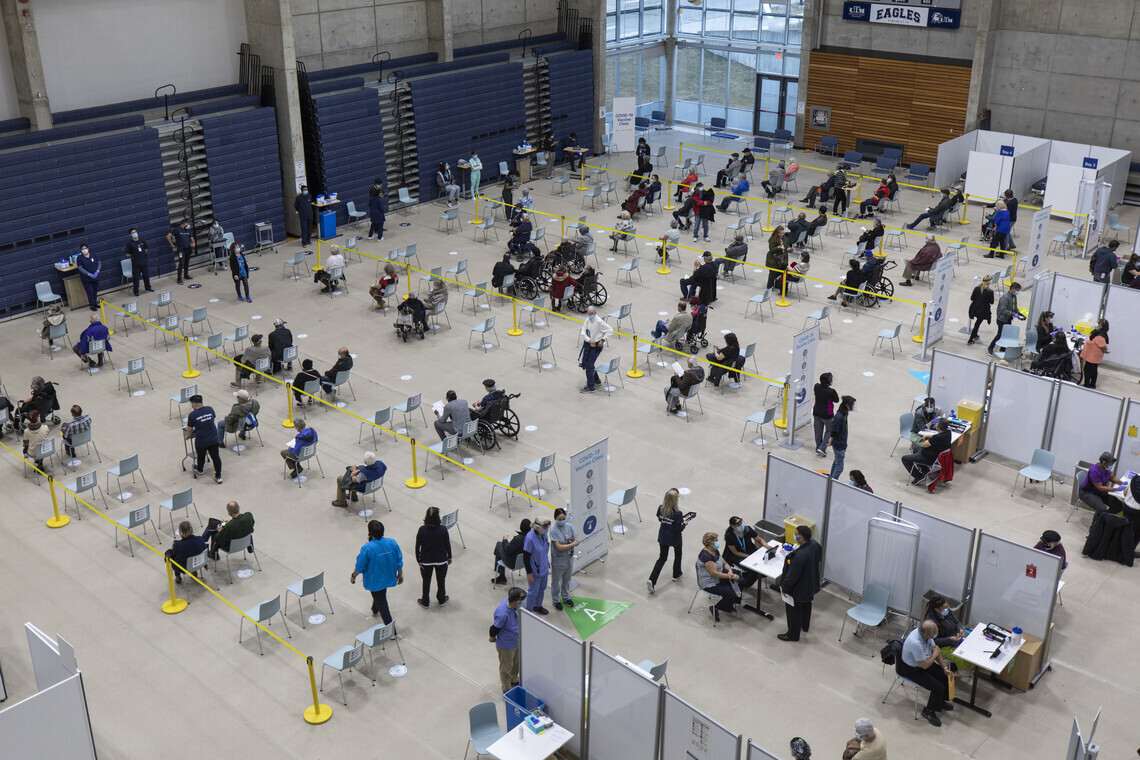Main Second Level Navigation
Breadcrumbs
- Home
- News & Events
- Recent News
- Canadian COVID-19 Deaths Second-Lowest Among G10 Nations: U of T Researchers
Canadian COVID-19 Deaths Second-Lowest Among G10 Nations: U of T Researchers

For much of the past two years, Canadians experienced some of the most restrictive public health measures in the world. Now, University of Toronto researchers have published the first analysis of how Canada compared to peer countries in terms of public health and control measures, deaths related to COVID-19 and economic costs.
Canada had the highest two-dose vaccination rate, and fewer cases and deaths from COVID-19 than any other country in the G10 group of wealthy nations except Japan, the researchers found. Canada also had the second-lowest number of “excessive mortality” deaths during the past two years, a measure that flagged death rates higher than expected — both related and unrelated to COVID-19. But the country’s economic performance was middle of the pack for measures such as inflation and unemployment, and lowest in GDP growth.
The Canadian Medical Association Journal published the report, which was co-authored by Professors Fahad Razak, David Naylor and Arthur Slutsky of the department of medicine at U of T’s Temerty Faculty of Medicine. Razak and Naylor also hold appointments in the Institute of Health Policy, Management and Evaluation at U of T’s Dalla Lana School of Public Health.
Razak spoke with writer Heidi Singer about the paper, which examined the first two years of the pandemic. Razak is the scientific director of Ontario's COVID-19 Science Advisory Table, and an internist and epidemiologist at St. Michael’s Hospital, Unity Heath Toronto.
What’s your biggest takeaway from this analysis?
We followed some of the strictest restrictions and had the highest percentage of double-vaccinated people in the G10. In other words, the Canadian public did everything we asked them to do. They are the real heroes of the pandemic, and now we can see their actions may have resulted in significant benefit for Canada.
As well, our low death rates occurred despite very strained health-system capacity. We have far fewer hospital beds per capita than most OECD countries, for example. And yet we were able to manage through these waves of disease. That reflects the enormous contribution of all frontline workers and especially health workers.
Part of the challenge in answering the ‘how did we do?’ question is determining who reasonable comparator countries are. We looked for the largest grouping of countries that share similar political and economic models with Canada, and had similar health-system capacity. In addition, population and geographic size was also important to consider, as part of the challenge was responding to the logistics of population-wide infections. The G10 was the largest grouping we are aware of that fit these criteria.
You showed that if we had the same vaccination and COVID-19 death rates as the U.S., almost 70,000 more Canadians would have died of the virus during the past two years. Was that a surprise?
We’ve seen a lot of informal analysis suggesting Canada did well compared to many peer countries. But when we put together the full analysis it was striking how well we did in terms of the number of people who got sick and died, and in excess mortality. Considering our population size, 70,000 extra deaths is huge: each of us would probably have known someone who died personally if we followed the U.S. course. Everyone and every country had a miserable experience during the pandemic. But this relative comparison is important.
But what about total deaths? Given the social isolation and other restrictive public health measures, you’d expect to have missed things like cancer screenings or other important preventive health measures, or potentially have worsening mental health and substance use among other health issues. And for almost all countries, excess deaths did increase, but for Canada it was lower than most other countries.
But aren’t we just at the cusp of dealing with later disease diagnoses and other health problems?
Absolutely, that is possible. The excess mortality estimation is very important in this regard. We need to continue to look at it over the next few years. Right now, it suggests Canada had one-fifth of the excess mortality of the U.S., but does there start to become a rise in excess mortality over the next few years because of lingering problems? I think we’d be starting to see the signals of this now, but in five years we’ll have a much clearer picture.
How should these results help inform public health policy and communication?
The Canadian public rallied around public health measures and got the jab. But if you look at our current state, there’s a real deterioration of that solidarity and engagement. For example, our third-dose vaccination rate has dropped to the middle of the pack for the G10. People understandably want the pandemic to be over, but unfortunately it’s not, and our enemy here is a virus that can exploit fatigue and complacency. There needs to be a reengagement with the public, and part of that is pointing to how well we did. Getting the public on board for the challenges ahead, that’s the important hurdle now.
And we need to ask, what can we mirror from our successes going forward? For example, a central goal is to prevent viral transmission — we did that over the first two years with some of the most restrictive policies around business and school closures, and restrictions on public gatherings. We used a hammer. But with the clear understanding now that COVID-19 is aerosolized, we can take steps to both protect people and keep much of society functioning. That means having the highest vaccination possible, focusing on cleaning the air through improved ventilation and filtration, and wearing a mask indoors during periods of higher viral transmission. Closing schools and businesses again should only be an absolute last resort if all else fails and we are in crisis.
Japan was the outlier with the fewest deaths and the fewest public health restrictions despite an older population. What do you make of that?
It’s mysterious. What our data does show is that Japan’s successes weren’t due to public health measures in general or vaccination. So, we need to look elsewhere. Japan is a fairly homogenous population and doesn’t have any land borders. Researchers are looking into whether there could be some immunity due to genetics or previous coronavirus infections. They also have a very strong cultural acceptance of mask wearing. Maybe their adherence to this was much better as they recognized much earlier in the pandemic that the virus was aerosolized.
It's important to note that outside the G10, there are countries like New Zealand and Taiwan that had a much lower burden of disease than Canada. We’re not saying Canada did the best globally. We tried to pick the largest group of countries with similar economic and political systems and health system capacity so we could have reasonable comparisons with Canada. So even though our COVID-19 outcomes look very good compared to the G10, we still need to learn from these other countries.
Including economic impact in the study shows your concern about the impact of poverty and financial insecurity on health. And you did find that Canada’s GDP contracted the most among the countries studied.
That’s true, and it’s also true that we’re experiencing blistering inflation right now. But this is a global phenomenon. Our inflation rate is in middle of the pack for the G10. Our unemployment rates have dropped. So, my overall assessment of our economic performance would be “middle of the pack.”
But that said, I think we have not answered the ‘was it worth it?’ question. This isn’t a scientific question; it’s a moral, governance and values question. It’s about the trade-off between lives saved and lives disrupted. There are people who are going to say the economic impact is not worth it. I think that’s a conversation that the public and government need to have.
Do these results help us to understand whether it was vaccination or public health restrictions that saved more lives?
The short answer is no. The long answer is maybe, but this will require another study and ideally more data than we had available to us.
We know that both were incredibly important and absolutely saved lives. But there is a complex, time-dependent analysis that will have to be done as the waves of the pandemic had different intensity and different variants, and there is a combination of both vaccine-induced and infection-induced immunity. You would have to figure out the intersection of that with each of the specific public health measures. So, it’s actually a very complicated thing to disentangle.
News


